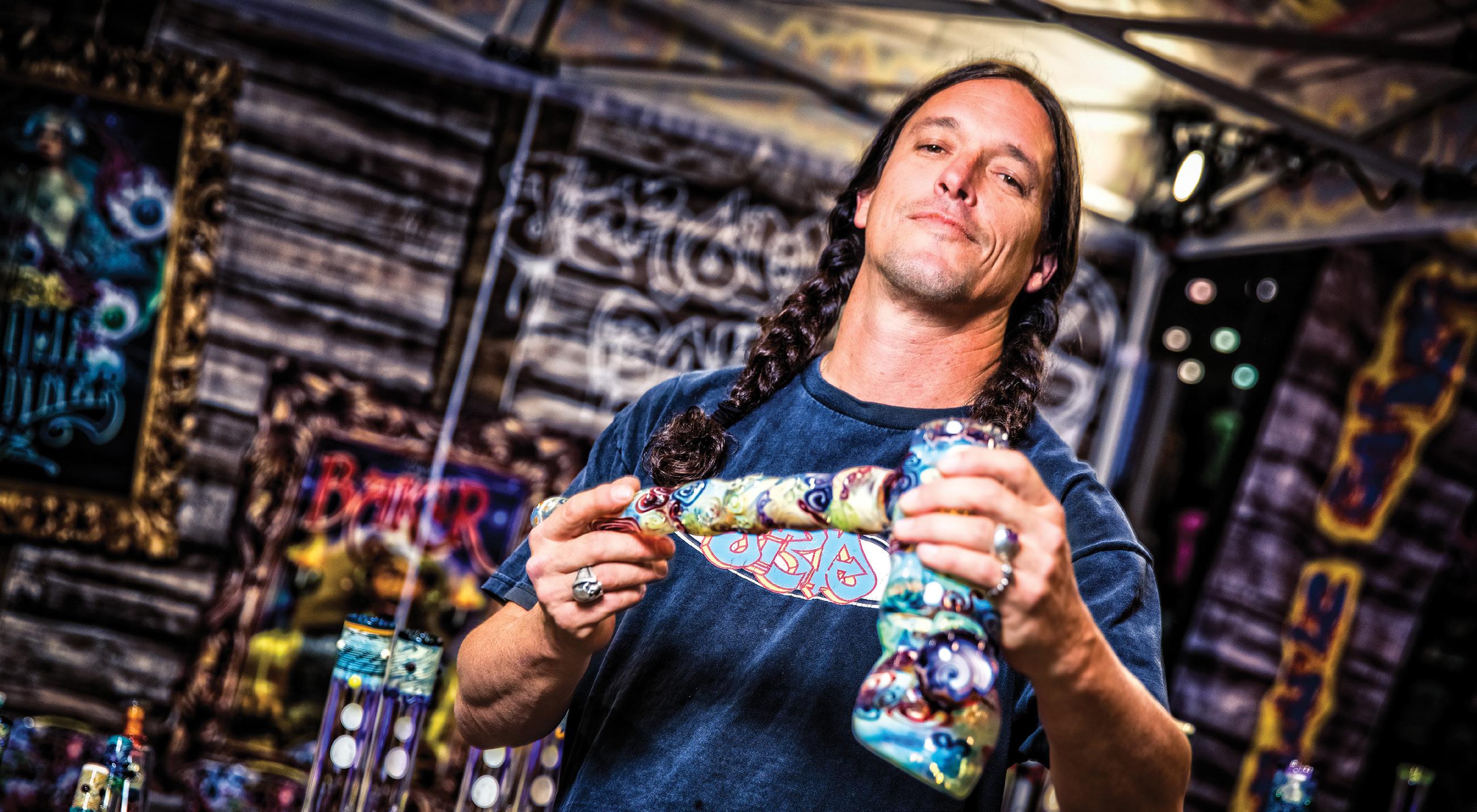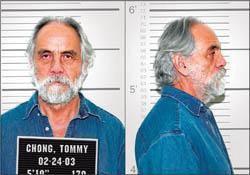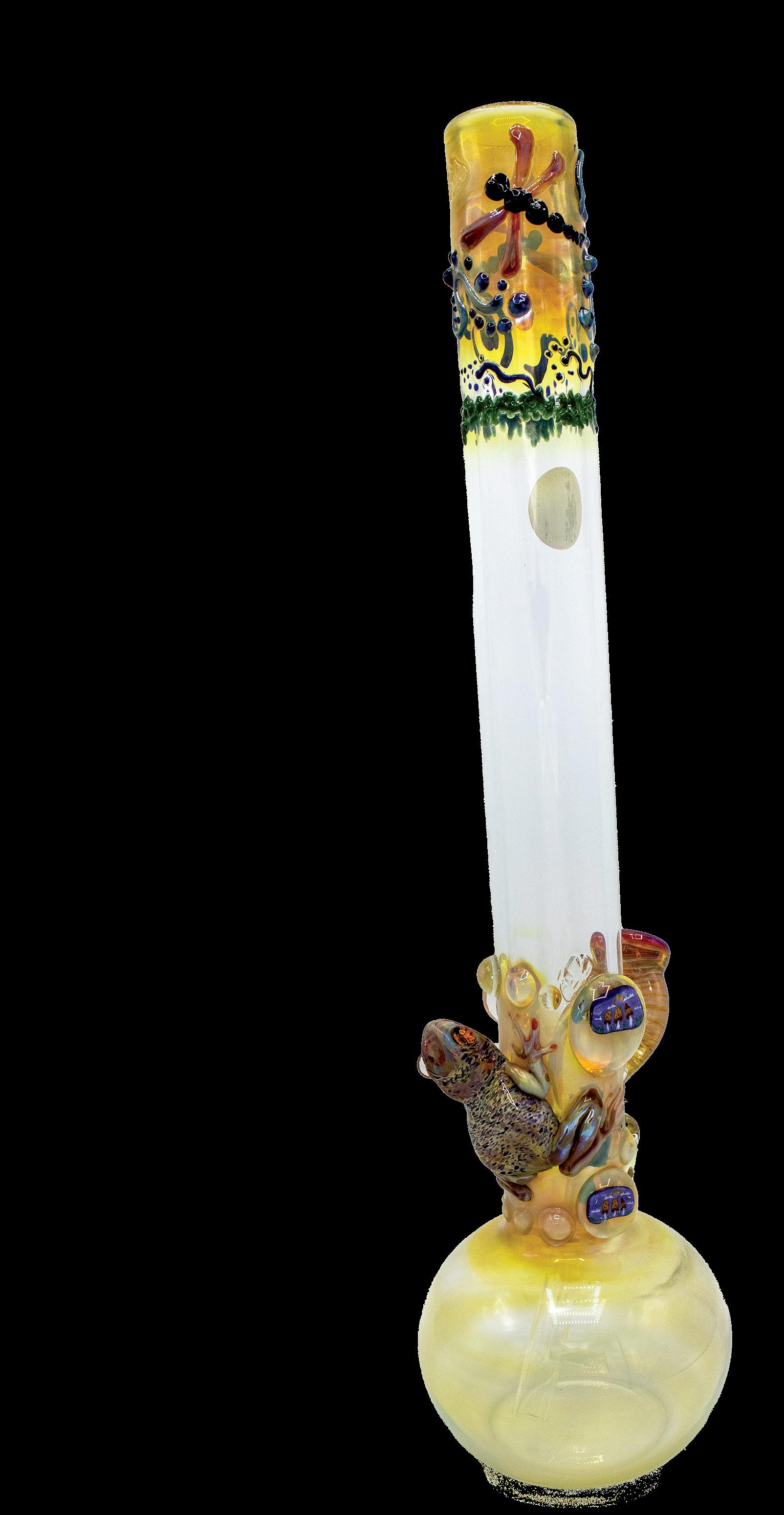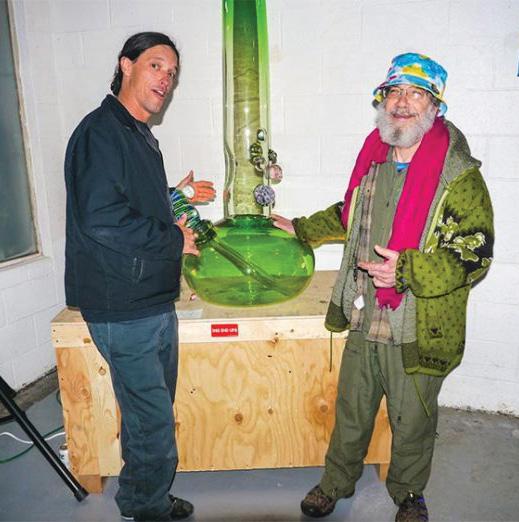
6 minute read
CANNTHROPOLOGY
from Apr. 2021 - California Leaf
by Northwest Leaf / Oregon Leaf / Alaska Leaf / Maryland Leaf / California Leaf / Northeast Leaf
PRESENTS


American Pipe Dreams
Jerome Baker Designs
When it comes to glass smokeware, it doesn’t get much more old school than Jerome Baker Designs. JBD helped to establish the modern glass industry and became the largest bong producer in the world … that is, until Operation Pipe Dreams caused the company to go up in smoke. Now, nearly 20 years later, they’ve risen from the ashes to reclaim their place of prominence in the glass game.
PYREX PIONEERS
The Jerome Baker story begins, unsurprisingly, in the parking lot of a Dead show in Massachusetts in July 1989. It was there that a college student from Miami named Jason Harris met a hippie pipe maker from Eugene, Oregon named Bob Snodgrass. Known as the Godfather of Glass, Snodgrass invented two groundbreaking glassblowing techniques: fuming (aka color-changing glass) and the “pushed-in bowl.” His individualism and ingenuity would inspire and influence all those to follow.
“There was just some magical attraction to Bob—he’s just that kind of being,” Harris says. “He was the coolest dude I’d ever met. I just wanted to be like him instantly.”
After graduating in 1991, Harris enrolled in the art program at the University of Oregon, moved out to Eugene and reached out to Snodgrass. In the months that followed, Harris saved his money, bought a torch, and began studying under Snodgrass as one of only 10 apprentices.
“There was an energy in the air surrounding that scene at the time,” he recalls fondly. “It was magical.”
In 1993, Harris and fellow apprentice Chris Shave (founder of Jah Creations Glass) started working together—first in a small garage down the street from Snodgrass, then in a larger studio with another fellow student, Dan K. It was Dan who introduced the group to the big Carlisle CC Burner torch and heavy wall glass, as well as the “wrap and rake” technique—all of which were game-changers for the budding industry.
Harris and Shave sold their pipes on the Dead tour, as well as at headshops in New York. To set himself apart and earn more money, Harris began making bongs rather than pipes—a technique he learned from Snoddy’s top student, Cameron Tower. He also took advantage of his mom’s flight attendant privileges to fly around the world and study glass art—working at glass shops in Italy, Germany, and even as far as India.
He also took courses at the esteemed Pilchuck glass school in Seattle, where he continued to hone his skills and expand his horizons. Then in 1995, he and partner Jordan Schefter formed their own company, which Harris decided to call Jerome Baker Designs—“Jerome,” an homage to Jerry Garcia who had recently died, and “Baker,” as in someone who gets “baked.”
“I wanted to have a brand name that everybody could get behind—something besides just my own name.”
One of JBD’s trademark styles was the Mothership—an orb-like base with a long shaft and a “snap and pull” downstem (a flared tube with a rubber seal that you pull out to carb)—an idea they borrowed from the Graffix bongs of the time. Unlike heady pieces, in which individual artists create unique works of art, JBD focused on production pieces, with various artists in their shop crafting different components and combining them in assembly-line fashion. This proved highly successful: By 1999, they’d become the largest smokeware company in the world—employing 70 glassblowers and earning $4 million a year. Among those caught up in the dragnet was famed Cannabis comedian Tommy Chong, whose companies Chong Glass Works and Nice Dreams had been entrapped by undercover agents into selling a bong across state lines.

OPERATION PIPE DREAMS
Around 6:00 a.m. on the morning of Monday, February 24, 2003, Harris was awakened by a pounding on his front door. Moments later, dozens of DEA agents in SWAT gear raided his home, hogtied him, threatened to shoot his dog, questioned him extensively, then hauled him off to county jail. Unbeknownst to him, his headshop, By 1999, they’d become the warehouse and production facility were largest smokeware company also simultaneously being raided. in the world—employing It wasn’t until Harris was watching TV through the bars of his jail cell that he realized the extent of what had gone 70 glassblowers and earning $4 million a year. down that day: In a news conference held by then-Attorney General John Ashcroft, he learned that his arrest was part of a multi-agency sting targeting glass producers across the country called Operation Pipe Dreams.
“Holy shit,” Harris thought to himself, “I’m in serious trouble!”
Among those caught up in the dragnet was famed Cannabis comedian Tommy Chong, whose companies Chong Glass Works and Nice Dreams had been entrapped by undercover agents into selling a bong across state lines. To spare his family, Tommy took the full rap—pleading guilty to conspiracy to distribute drug COURTESY JBD Harris, Snodgrass and a giant bong. paraphernalia. On September 11, 2003, he was sentenced to nine months in federal prison and a year of probation. Of all those charged as part of Operation Pipe Dreams, Chong was the only one to see actual prison time.
“By putting the celebrity in jail, they were using the justice system to make a political statement,” says Harris. “That’s what they did with Tommy.”
Thankfully, Harris’ deal allowed him to avoid jail time. In addition to paying massive fines and legal fees, he was sentenced to just one year of house arrest and five years probation.


JBD “pre-op” frog bong
DON’T CALL IT A COMEBACK
With pipe making off the table, Harris needed a new way to earn a living. First, he accepted a teaching position at his alma mater, the University of Oregon, as well as co-founding and working at the Eugene Glass School. Then in 2006, he moved to Maui and focused on surfing and creating high-end, non-functional glass art for tourists under a new company called Maui Glass Blowing.
But even though JBD was no longer making smokeware, Harris never abandoned the brand—instead transitioning it into a skater/ surfer lifestyle brand. While this never paid off financially, it kept the JBD brand relevant within the culture. It wasn’t until he experienced weed’s newly legal recreational status at the 2012 Cannabis Cup in Denver that he decided it was time for JBD to make a comeback. Using his skills, connections, name recognition, and an exciting new marketing tool called social media, Harris was able to re-establish JBD’s place of prominence in the glass industry within just a few years. Before long, they were producing custom pieces for A-list celebrities, and in 2018 made history by creating the world’s largest bongs. The biggest of the batch—dubbed “Bongzilla”—stood 24-feet tall and weighed 80 pounds, making its debut in October 2018 at Las Vegas’ Cannabition exhibit. That same year, JBD also opened their new headquarters in Vegas, which they named the Dream Factory. Last fall, JBD released a line of limited edition Chong Bongs with fellow former OPD target Tommy Chong, and this month are premiering a new glassblowing competition show on YouTube called Operation Pipe Dreamers with Chong as one of its judges. According to Harris—who’s now celebrating his 30th anniversary in the business—the show has two primary goals: The first is to document glass art and culture for posterity.
“If I make a bong and somebody buys it, and there are no pictures of it, it doesn’t get logged in our history,” says Harris. “We need to make sure that the OG vibe gets remembered and embedded into what this culture’s going to become.”
And the second goal? To help finally get Cannabis legalized nationwide. “Manufacturing drug paraphernalia is still illegal on a federal level. They can still come bust our doors down at any time,” he cautions. “The laws have to be changed.”
To go behind the glass with Jason Harris, listen to Episode #10 of our podcast at worldofcannabis.museum/podcast.Story and photos originally published on worldofcannabis.museum and reprinted with permission. Read the full extended version of this article on our website.










